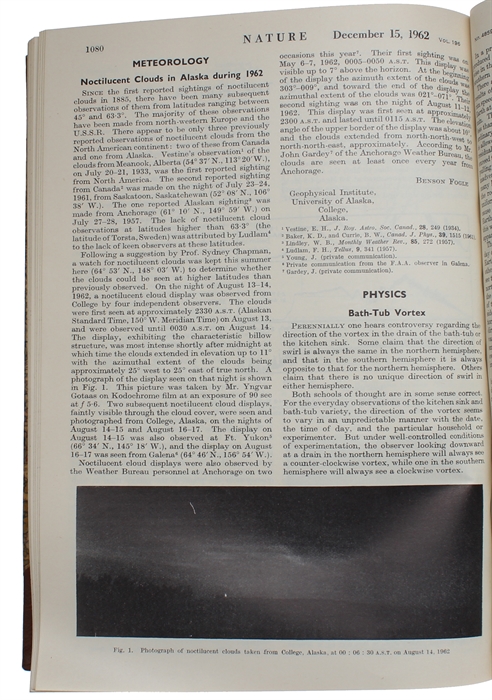THE CORIOLIS EFFECT ON A BATHTUB VORTEX
SWINTON, A. A. CAMPBELL.
Bath-Tub Vortex.
London, Macmillian, 1962.
Royal8vo. Bound in contemporary half calf with gilt lettering to spine. In "Nature", Vol. 196, October - December. Stamp to pasted down front end-paper and title-page. A fine copy. Pp. 1080-1. [Entire colume: LII, 1346 pp.].
First appearance of Shapiro's famous paper in which he sought to describe a bathtub vortex with the Coriolis Effect. This eventually gave birth to the urban myth that a toilet vortex always will have a counter clockwise flow in the Northern Hemisphere. The Coriolis effect on a micro level is still disputed and has never been satisfyingly confirmed or rejected.
Scientists were aware that Earth's rotation alters the trajectory of objects in motion. This phenomenon causes low-pressure weather systems to twist counterclockwise in the Northern Hemisphere and clockwise in the Southern Hemisphere. The Coriolis effect, as it's known, had long been well documented as the cause of hurricanes and tornadoes.
But despite previous attempts, no one had shown that the effect-first described in 1835 by the French engineer and mathematician Gustave-Gaspard Coriolis-works on very small scales as well. Though in theory it should influence bathwater's exit through a drain, the Coriolis effect was thought to be too small to see.
"For his experiment, Shapiro used a circular, flat-bottomed tub with a centered drain hole three-eighths of an inch in diameter to which he attached a 20-foot length of hose, plugged with a stopper at the end. He filled the tank six inches deep with clean, room-temperature water.
Small variations-air movement, a temperature change, a surface disturbance-create buoyancy currents that overshadow the Coriolis effect. So Shapiro did much tinkering to cancel out these possible sources of interference-covering the tank with a sheet of plastic to keep out air currents, for example, and carefully controlling the room's temperature. He also filled the tank by swirling water in clockwise, so that if the water drained counterclockwise, the direction would not have been influenced by how the tank was filled.
After 24 hours of letting the water settle, Shapiro carefully pulled the plug from the end of the hose, gently placing above the drain a small float made of two crossed slivers of wood an inch long. It took about 20 minutes for the tub to drain completely. For the first 12 to 15 minutes, the float remained motionless. Then it began to rotate almost imperceptibly, counterclockwise, reaching a peak speed of approximately one revolution every three to four seconds.
Proving that the Coriolis effect can be detected in a bathtub-size tank, albeit under carefully controlled conditions, was a remarkable achievement. At MIT's latitude of 42°, the effect was "only thirty-millionths that of gravity, which is so small that it will be overcome by filling and even temperature differences and water impurities," reported one of many newspapers and periodicals covering the experiment.
Shapiro's results were published in Nature and verified by colleagues who used his technique to demonstrate a clockwise flow in the Southern Hemisphere. The findings fascinated a curious public of all ages. Shapiro would also become known for explaining and improving the aerodynamics of golf ball dimples, as well as for helping to develop the intra-aortic balloon for heart patients and devices to treat blood clots, asthma, emphysema, and glaucoma. But for more than a decade after the bathtub test, he would receive letters and newspaper clippings from all over the world about what was dubbed the "bathtub vortex" controversy. " (MIT Technology Review).
Order-nr.: 59906


